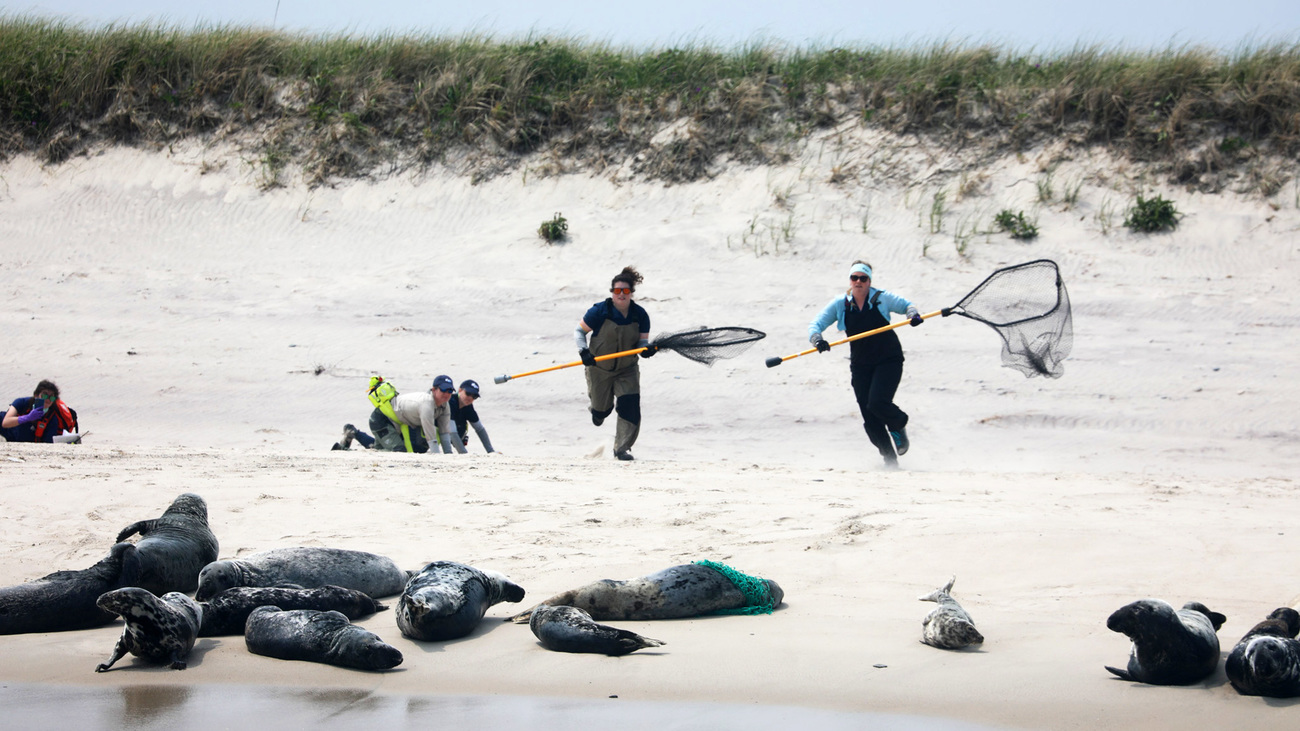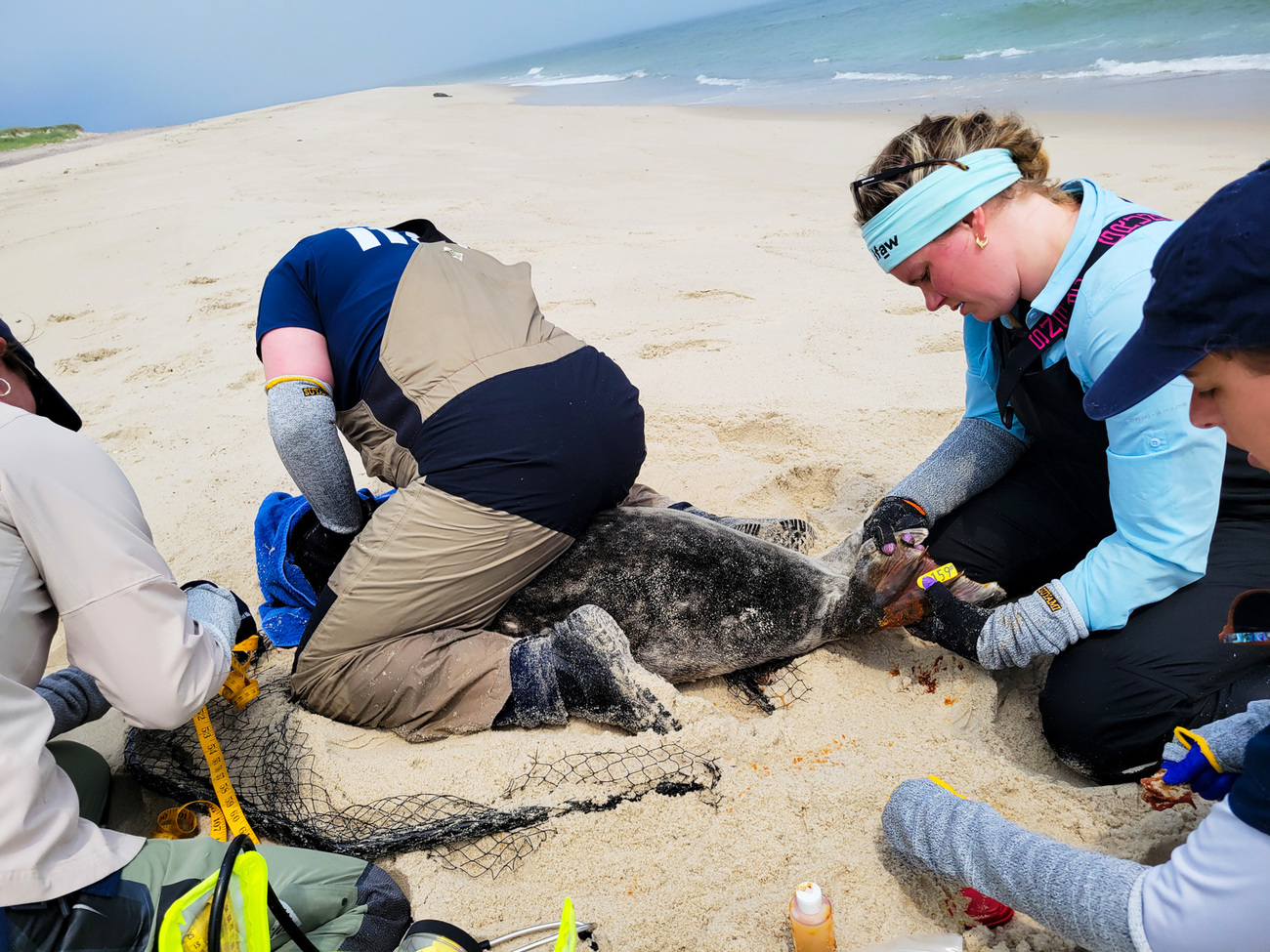Rescuing a seal from a deadly entanglement
Rescuing a seal from a deadly entanglement
By Olivia Guerra, IFAW Animal Rescue Responder and Biologist
On 2 June 2025, our marine mammal rescue hotline received an urgent call—a severely entangled adult male grey seal was spotted on Monomoy, a remote island off Chatham, Cape Cod. A significant amount of green multifilament net not only was cutting into the animal’s neck but also impacted his ability to move and behave normally.
With the area being so remote and only accessible by boat, we needed to wait a few days while planning fell into place and we awaited further reports from our colleagues at the National Monomoy Wildlife Refuge. On 5 June 5, the seal was sighted again in the same location, and with permissions from Monomoy staff, we gained access to the island the following day to rescue him.
Our team surveyed the island from the sea and successfully located the seal. Surrounded by at least 30 other grey seals as he lay on the beach with a three-pound green plastic fishing net around his neck, you couldn’t miss him.
Disentanglement is a tricky process. It’s not as simple as just using a pair of scissors to cut off the offending object and then letting the animal go free.
Weighing about 180 kilograms (400 pounds), he is a large wild animal that is very unpredictable. It takes experienced personnel to safely capture a seal of his size and secure him long enough to remove the entanglement without risking injury to him or our team members.
Our team stealthily disembarked from the boat and snuck up on him using the dunes as coverage. We set up our capture nets and crawled on our bellies so the seals wouldn’t spot us—spook one, and we’d spook them all. Then, we ran, as fast as possible, and successfully captured him with the hoop net before he could retreat to the water. Believe it or not, seals can be quite fast on land!
Due to his size, the net began to crack. Thankfully, Emily quickly helped me secure him, and the rest of the team joined us to start disentangling him.
Even with three experienced staff members restraining him, he was strong and difficult to keep still. But we managed to disentangle him in just four minutes.

As our veterinarian cut through the green netting and removed it from his body, she was able to assess the wounds the gear left behind from weeks of abrading and lacerating his head and neck. Even though the entanglement had lacerated into his blubber and muscle, our veterinarian determined that the best course of action was to immediately release him, as his wounds would be able to heal on their own.
Around the world, animals like seals, dolphins, whales, and sea turtles become trapped in lost or discarded fishing gear or are accidentally caught by fishers. Entanglement kills hundreds of thousands of marine mammals and turtles every year, and their deaths are often slow and painful. Nets and lines can restrict them from eating, causing them to starve; can prevent them from swimming to the surface to breathe, leading to drowning; or can cause lacerations in their skin that can become infected.

Historically, seals have been difficult to capture and disentangle. But IFAW has developed safe and effective techniques for rescuing them, sparing seals from significant pain and suffering.
But our work for the day wasn’t done. Just moments after we released the adult male, one of our staff positioned on our vessel radioed to the team that there was an entangled juvenile grey seal, wrapped in white polypropylene twine.
We still had a partially functional net, so Emily and I quickly got into position, and within a few seconds, she successfully captured him. He was much smaller than the adult male, requiring only one person to restrain him.
The rest of us quickly began disentangling him and assessing his overall condition. The entanglement left a superficial laceration on one side of his neck, but otherwise he was in good health and was not impressed with us. He was ready to go back to the ocean!
Because he was easier to handle, we were able to apply a small tag to his left rear flipper so that if he shows up somewhere else, we will know it’s him.

It was an incredible and emotional moment watching both animals make their way back to the water free of these life-threatening entanglements. We are so happy to have the skills, equipment, and expertise to be able to give these animals a second chance at life. We’re able to do so thanks to people like you who support our work, report sightings of entangled or stranded marine mammals, and donate to protect wildlife.
If you see a marine mammal in distress on Cape Cod or southeastern Massachusetts, please keep a safe distance (46 metres or 150 feet) from the animal and call our hotline: 508-743-9548.
Related content
Our work can’t get done without you. Please give what you can to help animals thrive.